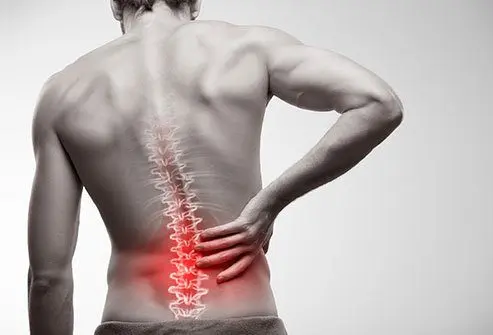Contents
Low back pain
La lumbago is the medical term for lower back pain, in the region of the lumbar vertebrae (see diagram). It is the most common form of back pain and most often not serious. More than 80% of people will suffer from low back pain one day or another43 and the prevalence of this disease continues to increase. It can occur at all ages, with peaks of onset in adolescence and around 45 years.43.
Types of low back pain: acute or chronic
Low back pain is the form of back pain most common. Indeed, the lumbar vertebrae are constantly stressed and support a significant part of the body weight, which makes it a fragile region.
Acute low back pain: lumbago
Acute pain that can last up to about 4 weeks (this is sometimes also called kidney pain). Although it is short-lived, acute low back pain can cause a lot of discomfort, require time off work and significantly interfere with daily activities. Over 90% of acute low back pain goes away or improves greatly on its own in 4 weeks or less.
Chronic low back pain
Constant pain that lasts more than 3 months. The causes of chronic low back pain are sometimes difficult to determine. People who suffer from it often have to consider making major lifestyle changes. About 5% to 8% of low back pain becomes chronic45.
To find out more about chronic pain, see our file: When we’re in pain all the time …
Back pain is a complex problem that conventional medicine alone cannot always relieve. In many cases, and especially if the pain is chronic, a comprehensive approach that takes into account psychological and emotional factors as well as physical ones is necessary. We can thus reduce the pain or, at least, learn to live better with it.
The lumbar spine The lumbar spine is made up of 5 vertebrae : small cylindrical bones superimposed and empty in their center (see diagram). The spinal cord passes through this cavity. The marrow is made up of a bundle of motor, sensory and associative nerve fibers. Between each vertebra is an intervertebral disc made up of flexible tissue enclosing a “gel”. The function of intervertebral discs is to allow mobility of the vertebrae and to absorb shocks. The whole is surrounded by muscles, tendons and ligaments which ensure the stability and mobility of the delicate joints of the spine. All of these structures can be responsible for lower back pain. |
Causes :
La lumbago is only symptom the causes of which are very varied. In nearly 90% of cases, low back pain is benign, or “nonspecific”. This means that there is no major lesion that could explain the pain.47. These can then be related to the intervertebral discs, vertebrae, muscles, etc. Most of the time, it is impossible to precisely determine the origin of the pain, which resolves spontaneously within a few weeks.
For this reason, the doctor will not prescribeimaging test (x-ray, scan, magnetic resonance) when the situation is clearly non-specific, without any worrying features. In other cases, especially in the presence of neurological symptoms, imaging is indicated. In rare cases, low back pain may be a sign of serious illness.
Here are the most common causes of pain.
- An injury to a muscle, tendon or ligament. It can come from exertion, an unusual twist or the accumulation of micro-lesions caused by repetitive movements. People in poor physical shape or exercising physical trades (construction, carrying heavy loads, etc.) are the most at risk.
- Disc degeneration. With aging, the intervertebral discs lose their elasticity. Disc degeneration is noticed in almost everyone over the age of 60. Some athletes also experience this problem around their forties, especially those who practice an activity that puts pressure on the spine. This degeneration is not always associated with pain, but it can be involved in some low back pain.
- A herniated disc. It occurs when part of the gel contained in the intervertebral disc protrudes outward and compresses the nerve roots. Poor posture, excess weight, pregnancy and degeneration of the disc are the main causes of herniated discs.
- A gynecological problem. Many women experience back pain periodically or constantly, due to painful periods, endometriosis, etc. The source of the pain is therefore not located in the lumbar region, but the pain still radiates to the lower back.
- The sliding of one vertebra on another vertebra (spondylolisthesis). This situation can occur due to a congenital weakness in the spinal structures or as a result of trauma.
- Arthritis, osteoarthritis or osteoporosis. These health problems are common in older people. If the osteoporosis of the spine is severe, it can cause a spinal fracture. Some inflammatory rheumatism, such as ankylosing spondylitis, can also cause pain and stiffness in the lower back.
- In rare cases, low back pain can be caused by an abdominal aortic aneurysm, tumor, osteoporse-related fracture, or infection.
Regardless of the origin of the back pain, there is often a contraction muscles near the sore area. It is a reflex of protected. This contraction can itself cause pain. A vicious circle can then be set in motion and contribute to making the pain chronic.










